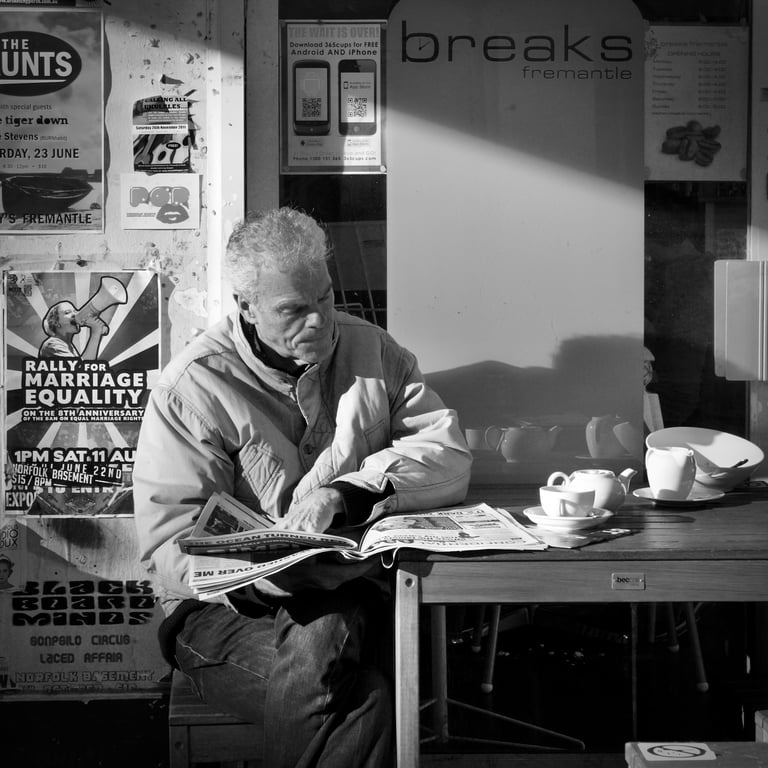Storytelling Through Street Photography
How to Capture a Narrative in a Single Shot
PHOTOGRAPHY PERSPECTIVES


Capturing a narrative in street photography is like telling a short story with a single image. It’s all about conveying a sense of place, emotion, or action that speaks volumes beyond the static elements of the photo. But how do you go about capturing a story through your lens? Let's break it down in a casual chat about making your photos speak.
What’s a Narrative?
In street photography, a narrative transcends mere visual documentation to weave a story that engages the viewer on multiple levels. It isn't just about what is overtly depicted in the frame but also about the underlying tales that those images evoke. Essentially, the narrative is the story your photo tells, which can be as varied as the bustling energy of a crowded street, a solitary figure lost in thought in a quiet corner of a café, or the reflective surfaces of an urban landscape following a rainstorm.
The narrative in a photograph might capture a moment of action or a scene of stillness, but the key is the interaction of the elements within the frame. These elements—whether people, objects, lighting, or even shadows—serve as the characters and setting of your visual story. For example, a photograph of a busy market might not only show traders and customers but also the chaos and color of the market itself, the textures of the goods for sale, and the dynamic interactions between people. Each component works together to convey a sense of place and activity, inviting the viewer to feel the clamor and the commerce of the setting.
Alternatively, a narrative might focus on a quieter, more introspective scene, such as a person sitting alone in a café. Here, the story could be in the subtle details: the way the subject's eyes might be directed out a rain-streaked window, the steam rising from a cup of coffee, or a half-finished crossword puzzle lying on the table. These elements suggest a backstory and emotional state, perhaps of contemplation or loneliness, triggering the viewer’s own memories or feelings of similar moments.
Moreover, narratives can also emerge from the aftermath of events, like a city street glistening after a rainstorm. Such a scene might depict people re-emerging with umbrellas, reflections in puddles, or the heightened colors of wet surfaces. Each of these elements contributes to a narrative about resilience or renewal, as the city comes back to life after the cleansing chaos of the storm.
What’s powerful about narrative photography is its ability to not just show a scene but to invite the viewer into it. By triggering the imagination, emotions, or memories, a narrative makes the viewer an active participant in the story. It prompts them to ponder not just what is happening in the photo, but what might have led up to that moment, or what might happen next. It’s this interactive quality that elevates a photograph from a simple image to a compelling narrative, capable of conveying depth and meaning that resonate with the viewer’s own life and experiences.
Do You Need People or Pets?
The presence of people or pets in a photograph often adds an immediate and relatable element of life and interaction, thanks to their expressive nature and capacity for visible emotion. However, incorporating living subjects is not a prerequisite for crafting a compelling narrative in photography. The absence of animate figures can equally serve to evoke powerful stories, sometimes even more mysterious or poignant, precisely because of what is left unsaid or unseen.
Consider the potent narrative potential of an empty street. Such a scene might evoke feelings of solitude or abandonment, depending on the context set by the time of day, the weather, and the environment. An empty street under the harsh noon sun might tell a story of a siesta time in a sleepy town, while the same street shrouded in mist at dawn could suggest desolation or the eerie calm before something significant occurs.
Similarly, a brightly lit window in a dark alley offers a glimpse into a hidden world, igniting the viewer's curiosity about the activities inside. It stands as a beacon of life amidst the shadowy unknown, suggesting warmth, mystery, or solitude. What is happening behind that illuminated window? Is someone reading a book, lost in their thoughts, or perhaps a family gathering? The possibilities for storytelling are endless and invite the viewer to fill in the blanks with their imagination.
Moreover, a scene featuring a series of discarded items—say, a forgotten doll, a broken bicycle, or a hat left behind on a park bench—can also create a rich narrative backdrop. These objects, while inanimate, hold the echoes of their past use. They can conjure stories about the people who once owned them, the places they've been, and the reasons they were left behind. Each object can serve as a relic of a personal history, imbuing the scene with a sense of nostalgia or loss.
In many street photography groups, there's a requirement that a human element must be present to convey the narrative. Even so, focusing on small details and incorporating them effectively alongside people within the composition can significantly enrich the stories being told. Photographers can use these non-human elements to add depth and context to the human activity or presence in the frame. For example, a person reading beside a forgotten toy on a park bench could suggest a story of parenthood, nostalgia, or loss.
The key is to integrate these elements in a way that complements and enhances the human presence, engaging the viewer’s senses and imagination. By doing so, photographers encourage viewers to construct their own stories from the visual clues provided, making the narrative more layered and multifaceted. This approach not only adheres to the rules of certain photography groups but also expands the narrative possibilities within photography and enhances the viewer's active participation in interpreting the art.
Storytelling Through Street Photography: How to Capture a Narrative in a Single Shot
Capturing the Story
Look for Emotions and Interactions: Capturing human expressions and interactions provides a direct window into the story you want to tell. The subtleties of a smile, the intensity of a gaze, or the dynamics between two people engrossed in conversation all contribute layers of depth to a photograph. But the narrative potential isn't confined to human subjects alone. Consider the way pets or animals in urban settings engage with their surroundings or each other. A dog intently watching the bustling street, or pigeons congregating around a shared meal on a city sidewalk can add a poignant or whimsical note to your image. These interactions, whether between animals themselves or between humans and animals, can subtly highlight themes of companionship, alienation, or coexistence within the urban maze.
Pay Attention to Details: It’s often the minor, overlooked details that stitch the fabric of a scene together. A child's forgotten toy left in the grass can evoke a sense of nostalgia or loss, hinting at a story of play interrupted. An old book discarded on a park bench might suggest a moment of leisure or a sudden change, perhaps an abrupt call that pulled someone away. Even a pair of worn-out shoes visible beneath a street curtain can tell a poignant tale of poverty or a long journey taken. These elements, while small, serve as powerful narrative tools that invite the viewer to piece together the backstory, enriching the overall composition and emotional resonance of the scene.
Set the Scene: The setting of your photograph acts as the stage for your narrative. Each environment carries its own historical and emotional weight. An old cobblestone street, with its worn surfaces and traditional architecture, naturally evokes a sense of history and nostalgia, suggesting tales of the past echoing through the present. Conversely, a photograph set against the backdrop of a sleek, modern skyscraper, with its reflective glass and towering form, might communicate themes of innovation, isolation, or the impersonal nature of contemporary urban life. The choice of setting can dramatically alter the story’s tone, influencing the viewer’s perception and emotional response to the image.
Consider the Atmosphere: Atmospheric conditions can dramatically enhance the narrative quality of your photographs. For instance, fog not only obscures but also mystifies a scene, enveloping the ordinary in a cloak of mystery and inviting the viewer to look closer. Harsh sunlight creates bold contrasts and shadows, often used to heighten feelings of drama or highlight conflict within the frame. Conversely, the soft, diffused light of the golden hour can bathe the scene in warmth, making even the most mundane urban landscapes appear dreamy and romantic. Leveraging these elements of weather and lighting can transform the narrative, adding layers of meaning and emotional depth to your visual story.
Dynamic Composition: Effective composition is crucial in narrative photography. It’s about more than just capturing a moment—it's about guiding the viewer’s eye to the essential elements of the story. Utilizing techniques like leading lines, which could be a pathway, a street, or rows of architecture, draws the viewer into the scene, creating a sense of depth and perspective. Framing can also be used to highlight key elements, using windows, arches, or overhanging branches to isolate and direct attention to specific parts of your narrative. The rule of thirds, where the frame is divided into nine equal segments, provides a balanced structure, helping to place your story’s subjects in a context that feels both dynamic and harmoniously composed. Each of these techniques serves to enhance the story elements, making the photograph not only aesthetically pleasing but also richly storied.
Summary
By engaging the viewer’s senses, narrative photography can evoke the smell of rain on city streets, the sound of laughter, the quietness of an early morning, or the tension of a crowded space. It’s about creating an immersive experience that transcends the visual, making the viewer feel as though they could step into the frame and become part of the unfolding story.
Your aim as a photographer is to be a storyteller whose medium is the camera. Each shot you take is a sentence, each sequence a paragraph in the larger story you're telling. Keep your eyes open and your mind alert to the possibilities around you. What narrative is unfolding in the interaction between those two people across the street? What story is whispered by the worn-out shoes abandoned by the park bench? Every element has a tale to tell; your job is to capture it, frame it, and present it in such a way that your audience can't help but be drawn into the world you've observed.
So, arm yourself with your camera, let your intuition and creativity guide you, and shoot away. Remember, in the hustle and bustle of street photography, even the most mundane elements can weave compelling narratives that resonate deeply and evoke strong emotional responses from your audience.
© Peter Pickering 2024. www.peterpickering.com




